Brand Management Report: Building and Managing Brand Equity at M&S
VerifiedAdded on 2023/01/12
|20
|7018
|71
Report
AI Summary
This report delves into the multifaceted realm of brand management, exploring its significance as a marketing tool and its evolution within business practices. Using Marks and Spencer as a case study, the report examines the key components of a successful brand strategy, including target audience identification and public relations, while also illustrating the application of Keller's Brand Equity Model. It analyzes different strategies of portfolio management, brand hierarchy, and brand equity management, critically evaluating these strategies using relevant theories and frameworks. Furthermore, the report assesses collaborative brand management, both domestically and globally, and evaluates techniques for leveraging and extending brands. Finally, it explores methods for measuring and managing brand value, aiming to develop a strong and enduring brand.
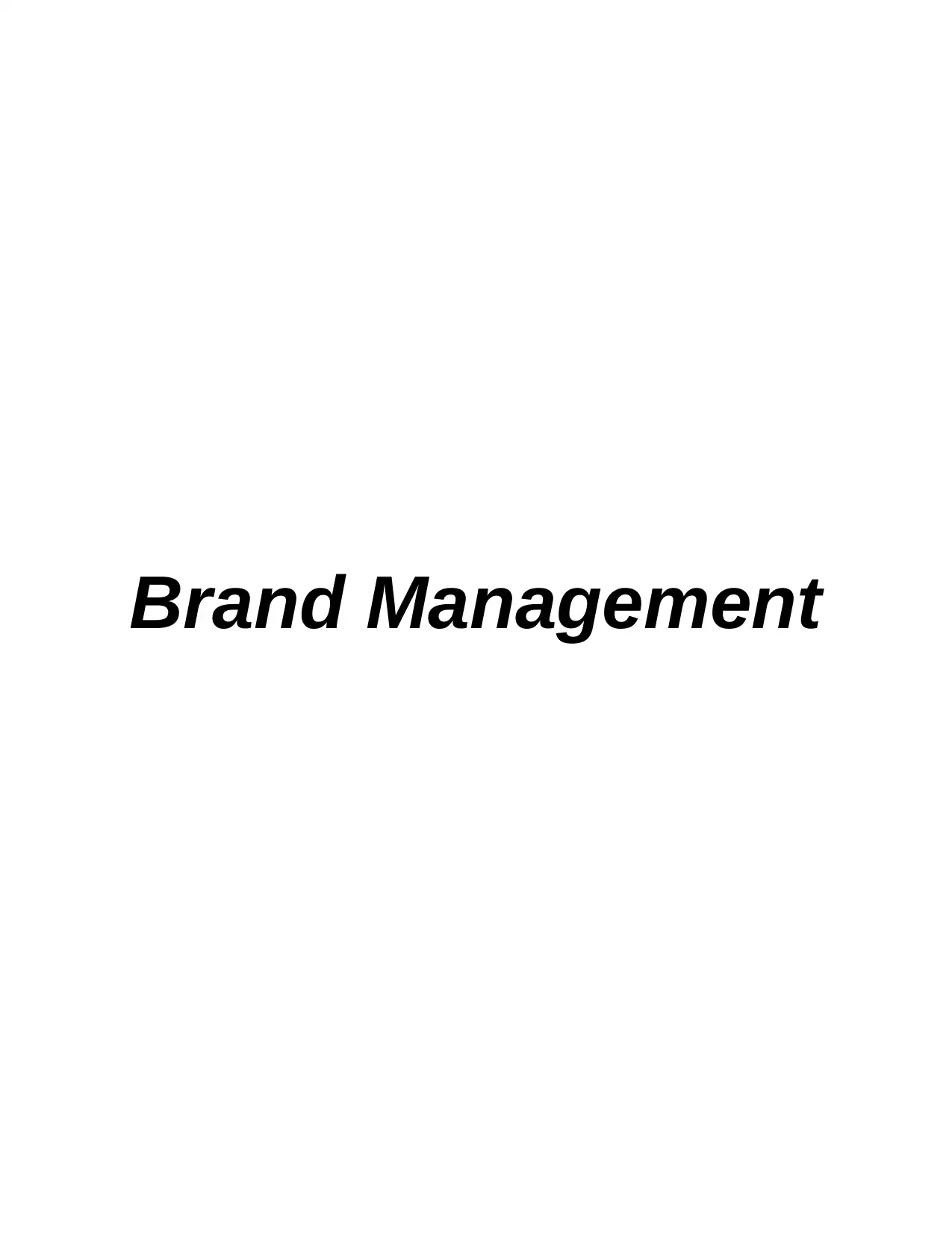
Brand Management
Paraphrase This Document
Need a fresh take? Get an instant paraphrase of this document with our AI Paraphraser
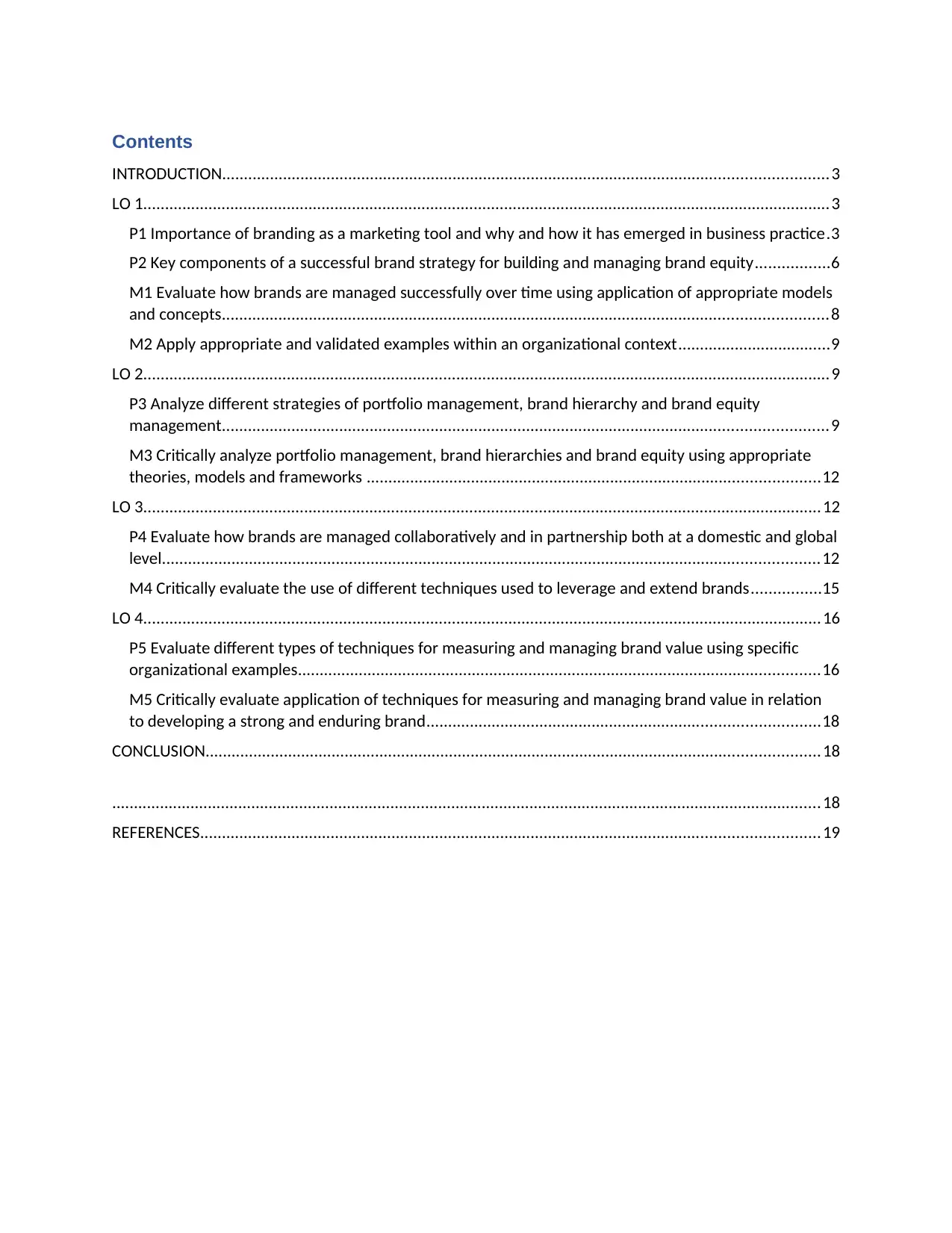
Contents
INTRODUCTION...........................................................................................................................................3
LO 1..............................................................................................................................................................3
P1 Importance of branding as a marketing tool and why and how it has emerged in business practice.3
P2 Key components of a successful brand strategy for building and managing brand equity.................6
M1 Evaluate how brands are managed successfully over time using application of appropriate models
and concepts...........................................................................................................................................8
M2 Apply appropriate and validated examples within an organizational context...................................9
LO 2..............................................................................................................................................................9
P3 Analyze different strategies of portfolio management, brand hierarchy and brand equity
management...........................................................................................................................................9
M3 Critically analyze portfolio management, brand hierarchies and brand equity using appropriate
theories, models and frameworks ........................................................................................................12
LO 3............................................................................................................................................................12
P4 Evaluate how brands are managed collaboratively and in partnership both at a domestic and global
level.......................................................................................................................................................12
M4 Critically evaluate the use of different techniques used to leverage and extend brands................15
LO 4............................................................................................................................................................16
P5 Evaluate different types of techniques for measuring and managing brand value using specific
organizational examples........................................................................................................................16
M5 Critically evaluate application of techniques for measuring and managing brand value in relation
to developing a strong and enduring brand..........................................................................................18
CONCLUSION.............................................................................................................................................18
...................................................................................................................................................................18
REFERENCES..............................................................................................................................................19
INTRODUCTION...........................................................................................................................................3
LO 1..............................................................................................................................................................3
P1 Importance of branding as a marketing tool and why and how it has emerged in business practice.3
P2 Key components of a successful brand strategy for building and managing brand equity.................6
M1 Evaluate how brands are managed successfully over time using application of appropriate models
and concepts...........................................................................................................................................8
M2 Apply appropriate and validated examples within an organizational context...................................9
LO 2..............................................................................................................................................................9
P3 Analyze different strategies of portfolio management, brand hierarchy and brand equity
management...........................................................................................................................................9
M3 Critically analyze portfolio management, brand hierarchies and brand equity using appropriate
theories, models and frameworks ........................................................................................................12
LO 3............................................................................................................................................................12
P4 Evaluate how brands are managed collaboratively and in partnership both at a domestic and global
level.......................................................................................................................................................12
M4 Critically evaluate the use of different techniques used to leverage and extend brands................15
LO 4............................................................................................................................................................16
P5 Evaluate different types of techniques for measuring and managing brand value using specific
organizational examples........................................................................................................................16
M5 Critically evaluate application of techniques for measuring and managing brand value in relation
to developing a strong and enduring brand..........................................................................................18
CONCLUSION.............................................................................................................................................18
...................................................................................................................................................................18
REFERENCES..............................................................................................................................................19
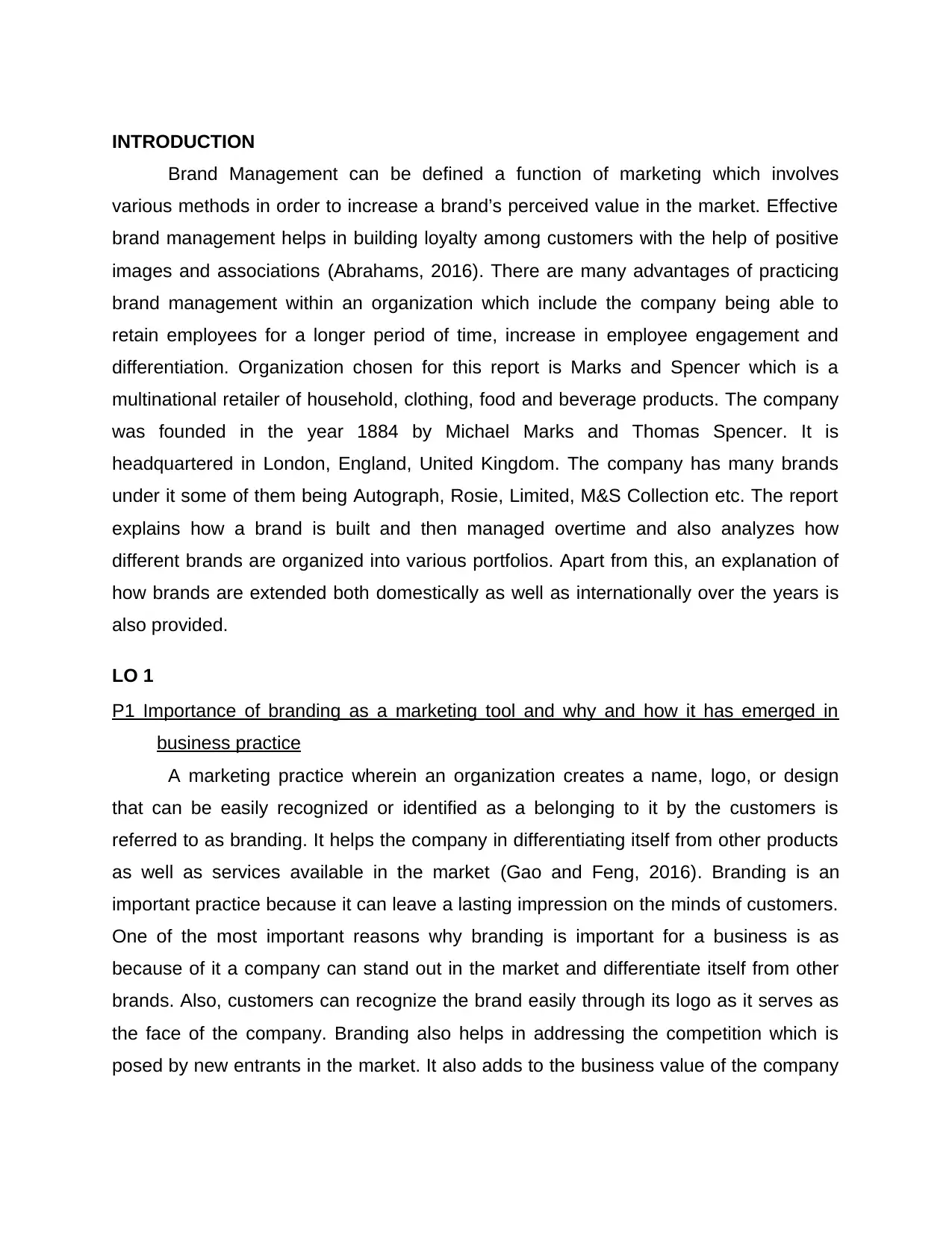
INTRODUCTION
Brand Management can be defined a function of marketing which involves
various methods in order to increase a brand’s perceived value in the market. Effective
brand management helps in building loyalty among customers with the help of positive
images and associations (Abrahams, 2016). There are many advantages of practicing
brand management within an organization which include the company being able to
retain employees for a longer period of time, increase in employee engagement and
differentiation. Organization chosen for this report is Marks and Spencer which is a
multinational retailer of household, clothing, food and beverage products. The company
was founded in the year 1884 by Michael Marks and Thomas Spencer. It is
headquartered in London, England, United Kingdom. The company has many brands
under it some of them being Autograph, Rosie, Limited, M&S Collection etc. The report
explains how a brand is built and then managed overtime and also analyzes how
different brands are organized into various portfolios. Apart from this, an explanation of
how brands are extended both domestically as well as internationally over the years is
also provided.
LO 1
P1 Importance of branding as a marketing tool and why and how it has emerged in
business practice
A marketing practice wherein an organization creates a name, logo, or design
that can be easily recognized or identified as a belonging to it by the customers is
referred to as branding. It helps the company in differentiating itself from other products
as well as services available in the market (Gao and Feng, 2016). Branding is an
important practice because it can leave a lasting impression on the minds of customers.
One of the most important reasons why branding is important for a business is as
because of it a company can stand out in the market and differentiate itself from other
brands. Also, customers can recognize the brand easily through its logo as it serves as
the face of the company. Branding also helps in addressing the competition which is
posed by new entrants in the market. It also adds to the business value of the company
Brand Management can be defined a function of marketing which involves
various methods in order to increase a brand’s perceived value in the market. Effective
brand management helps in building loyalty among customers with the help of positive
images and associations (Abrahams, 2016). There are many advantages of practicing
brand management within an organization which include the company being able to
retain employees for a longer period of time, increase in employee engagement and
differentiation. Organization chosen for this report is Marks and Spencer which is a
multinational retailer of household, clothing, food and beverage products. The company
was founded in the year 1884 by Michael Marks and Thomas Spencer. It is
headquartered in London, England, United Kingdom. The company has many brands
under it some of them being Autograph, Rosie, Limited, M&S Collection etc. The report
explains how a brand is built and then managed overtime and also analyzes how
different brands are organized into various portfolios. Apart from this, an explanation of
how brands are extended both domestically as well as internationally over the years is
also provided.
LO 1
P1 Importance of branding as a marketing tool and why and how it has emerged in
business practice
A marketing practice wherein an organization creates a name, logo, or design
that can be easily recognized or identified as a belonging to it by the customers is
referred to as branding. It helps the company in differentiating itself from other products
as well as services available in the market (Gao and Feng, 2016). Branding is an
important practice because it can leave a lasting impression on the minds of customers.
One of the most important reasons why branding is important for a business is as
because of it a company can stand out in the market and differentiate itself from other
brands. Also, customers can recognize the brand easily through its logo as it serves as
the face of the company. Branding also helps in addressing the competition which is
posed by new entrants in the market. It also adds to the business value of the company
⊘ This is a preview!⊘
Do you want full access?
Subscribe today to unlock all pages.

Trusted by 1+ million students worldwide
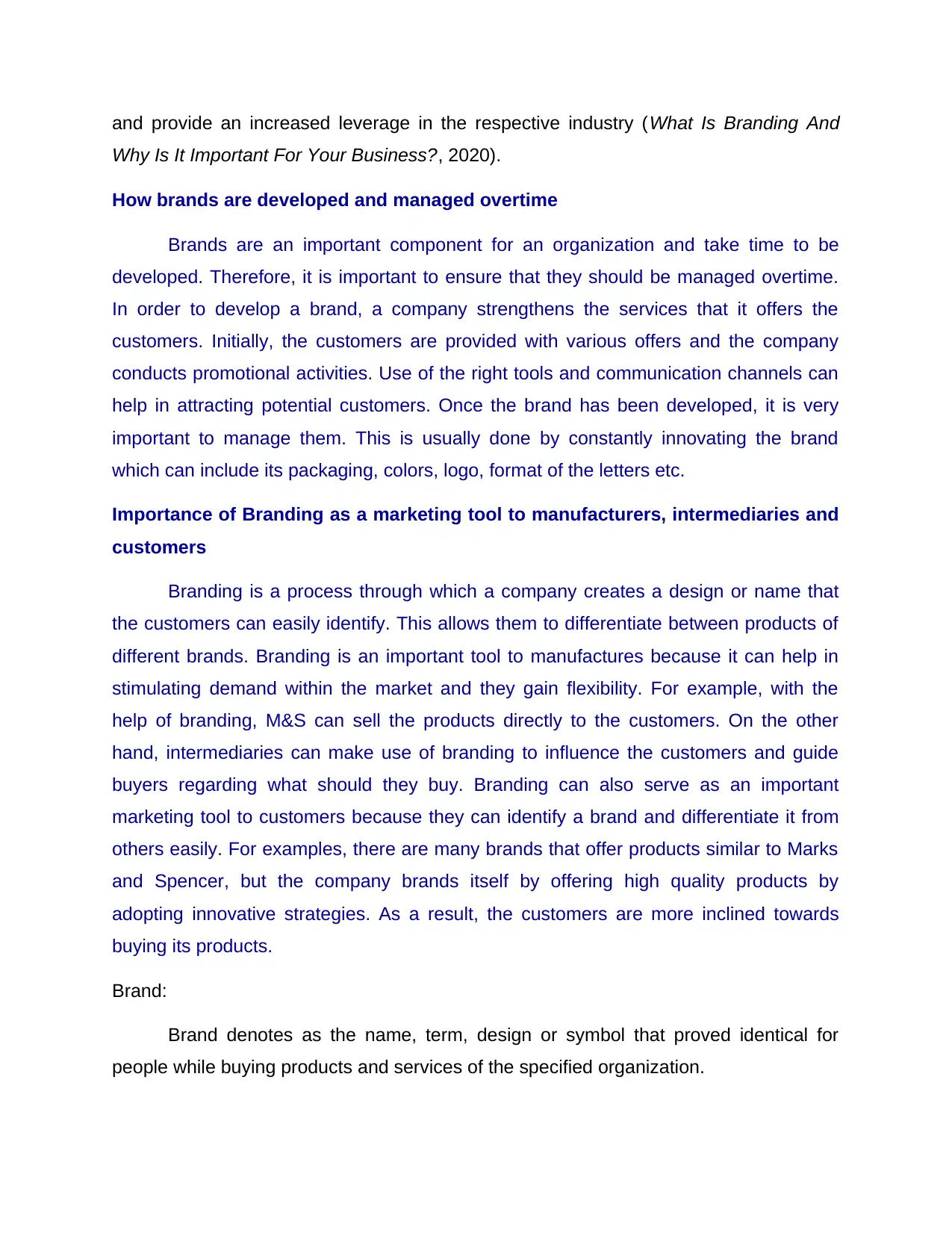
and provide an increased leverage in the respective industry (What Is Branding And
Why Is It Important For Your Business?, 2020).
How brands are developed and managed overtime
Brands are an important component for an organization and take time to be
developed. Therefore, it is important to ensure that they should be managed overtime.
In order to develop a brand, a company strengthens the services that it offers the
customers. Initially, the customers are provided with various offers and the company
conducts promotional activities. Use of the right tools and communication channels can
help in attracting potential customers. Once the brand has been developed, it is very
important to manage them. This is usually done by constantly innovating the brand
which can include its packaging, colors, logo, format of the letters etc.
Importance of Branding as a marketing tool to manufacturers, intermediaries and
customers
Branding is a process through which a company creates a design or name that
the customers can easily identify. This allows them to differentiate between products of
different brands. Branding is an important tool to manufactures because it can help in
stimulating demand within the market and they gain flexibility. For example, with the
help of branding, M&S can sell the products directly to the customers. On the other
hand, intermediaries can make use of branding to influence the customers and guide
buyers regarding what should they buy. Branding can also serve as an important
marketing tool to customers because they can identify a brand and differentiate it from
others easily. For examples, there are many brands that offer products similar to Marks
and Spencer, but the company brands itself by offering high quality products by
adopting innovative strategies. As a result, the customers are more inclined towards
buying its products.
Brand:
Brand denotes as the name, term, design or symbol that proved identical for
people while buying products and services of the specified organization.
Why Is It Important For Your Business?, 2020).
How brands are developed and managed overtime
Brands are an important component for an organization and take time to be
developed. Therefore, it is important to ensure that they should be managed overtime.
In order to develop a brand, a company strengthens the services that it offers the
customers. Initially, the customers are provided with various offers and the company
conducts promotional activities. Use of the right tools and communication channels can
help in attracting potential customers. Once the brand has been developed, it is very
important to manage them. This is usually done by constantly innovating the brand
which can include its packaging, colors, logo, format of the letters etc.
Importance of Branding as a marketing tool to manufacturers, intermediaries and
customers
Branding is a process through which a company creates a design or name that
the customers can easily identify. This allows them to differentiate between products of
different brands. Branding is an important tool to manufactures because it can help in
stimulating demand within the market and they gain flexibility. For example, with the
help of branding, M&S can sell the products directly to the customers. On the other
hand, intermediaries can make use of branding to influence the customers and guide
buyers regarding what should they buy. Branding can also serve as an important
marketing tool to customers because they can identify a brand and differentiate it from
others easily. For examples, there are many brands that offer products similar to Marks
and Spencer, but the company brands itself by offering high quality products by
adopting innovative strategies. As a result, the customers are more inclined towards
buying its products.
Brand:
Brand denotes as the name, term, design or symbol that proved identical for
people while buying products and services of the specified organization.
Paraphrase This Document
Need a fresh take? Get an instant paraphrase of this document with our AI Paraphraser
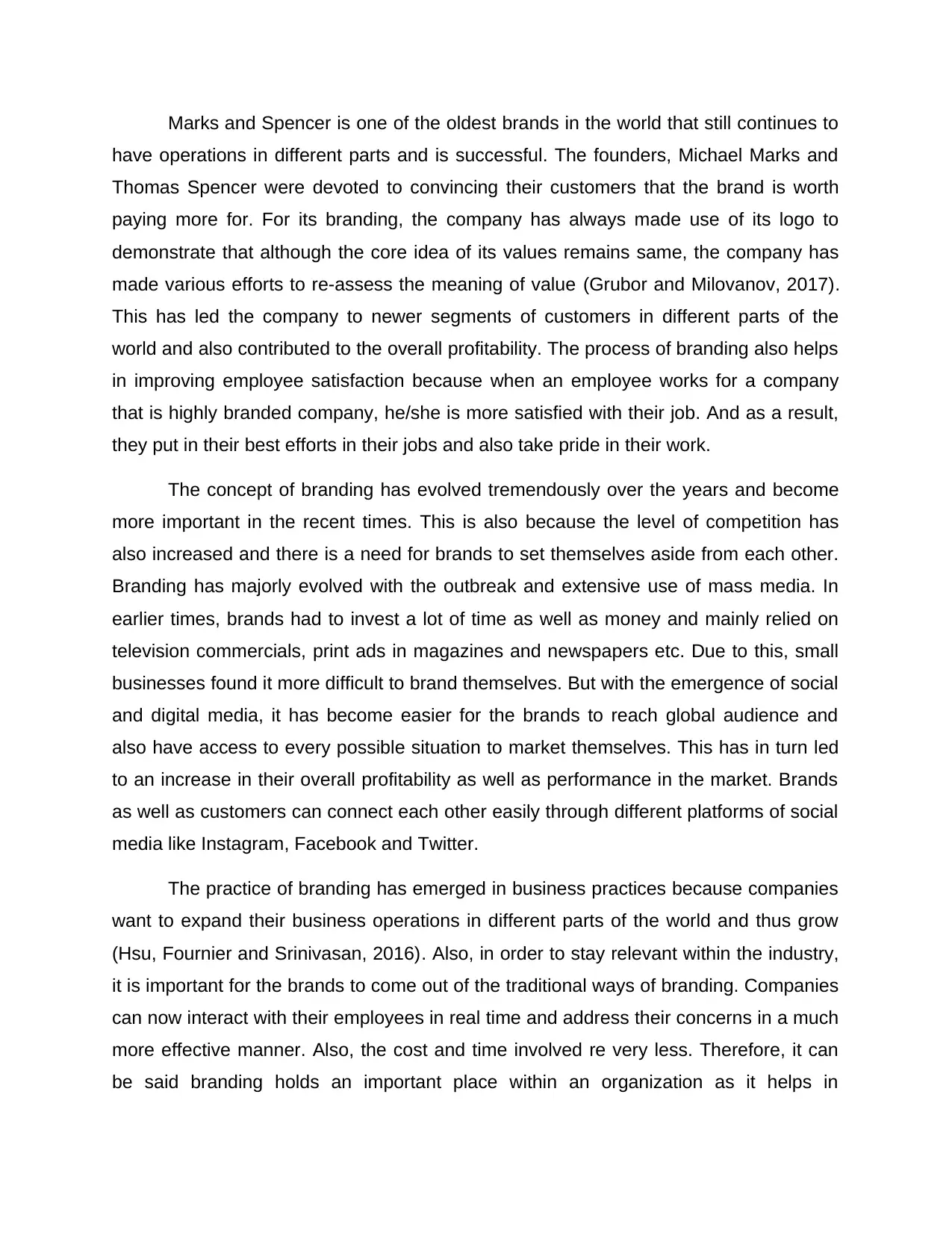
Marks and Spencer is one of the oldest brands in the world that still continues to
have operations in different parts and is successful. The founders, Michael Marks and
Thomas Spencer were devoted to convincing their customers that the brand is worth
paying more for. For its branding, the company has always made use of its logo to
demonstrate that although the core idea of its values remains same, the company has
made various efforts to re-assess the meaning of value (Grubor and Milovanov, 2017).
This has led the company to newer segments of customers in different parts of the
world and also contributed to the overall profitability. The process of branding also helps
in improving employee satisfaction because when an employee works for a company
that is highly branded company, he/she is more satisfied with their job. And as a result,
they put in their best efforts in their jobs and also take pride in their work.
The concept of branding has evolved tremendously over the years and become
more important in the recent times. This is also because the level of competition has
also increased and there is a need for brands to set themselves aside from each other.
Branding has majorly evolved with the outbreak and extensive use of mass media. In
earlier times, brands had to invest a lot of time as well as money and mainly relied on
television commercials, print ads in magazines and newspapers etc. Due to this, small
businesses found it more difficult to brand themselves. But with the emergence of social
and digital media, it has become easier for the brands to reach global audience and
also have access to every possible situation to market themselves. This has in turn led
to an increase in their overall profitability as well as performance in the market. Brands
as well as customers can connect each other easily through different platforms of social
media like Instagram, Facebook and Twitter.
The practice of branding has emerged in business practices because companies
want to expand their business operations in different parts of the world and thus grow
(Hsu, Fournier and Srinivasan, 2016). Also, in order to stay relevant within the industry,
it is important for the brands to come out of the traditional ways of branding. Companies
can now interact with their employees in real time and address their concerns in a much
more effective manner. Also, the cost and time involved re very less. Therefore, it can
be said branding holds an important place within an organization as it helps in
have operations in different parts and is successful. The founders, Michael Marks and
Thomas Spencer were devoted to convincing their customers that the brand is worth
paying more for. For its branding, the company has always made use of its logo to
demonstrate that although the core idea of its values remains same, the company has
made various efforts to re-assess the meaning of value (Grubor and Milovanov, 2017).
This has led the company to newer segments of customers in different parts of the
world and also contributed to the overall profitability. The process of branding also helps
in improving employee satisfaction because when an employee works for a company
that is highly branded company, he/she is more satisfied with their job. And as a result,
they put in their best efforts in their jobs and also take pride in their work.
The concept of branding has evolved tremendously over the years and become
more important in the recent times. This is also because the level of competition has
also increased and there is a need for brands to set themselves aside from each other.
Branding has majorly evolved with the outbreak and extensive use of mass media. In
earlier times, brands had to invest a lot of time as well as money and mainly relied on
television commercials, print ads in magazines and newspapers etc. Due to this, small
businesses found it more difficult to brand themselves. But with the emergence of social
and digital media, it has become easier for the brands to reach global audience and
also have access to every possible situation to market themselves. This has in turn led
to an increase in their overall profitability as well as performance in the market. Brands
as well as customers can connect each other easily through different platforms of social
media like Instagram, Facebook and Twitter.
The practice of branding has emerged in business practices because companies
want to expand their business operations in different parts of the world and thus grow
(Hsu, Fournier and Srinivasan, 2016). Also, in order to stay relevant within the industry,
it is important for the brands to come out of the traditional ways of branding. Companies
can now interact with their employees in real time and address their concerns in a much
more effective manner. Also, the cost and time involved re very less. Therefore, it can
be said branding holds an important place within an organization as it helps in
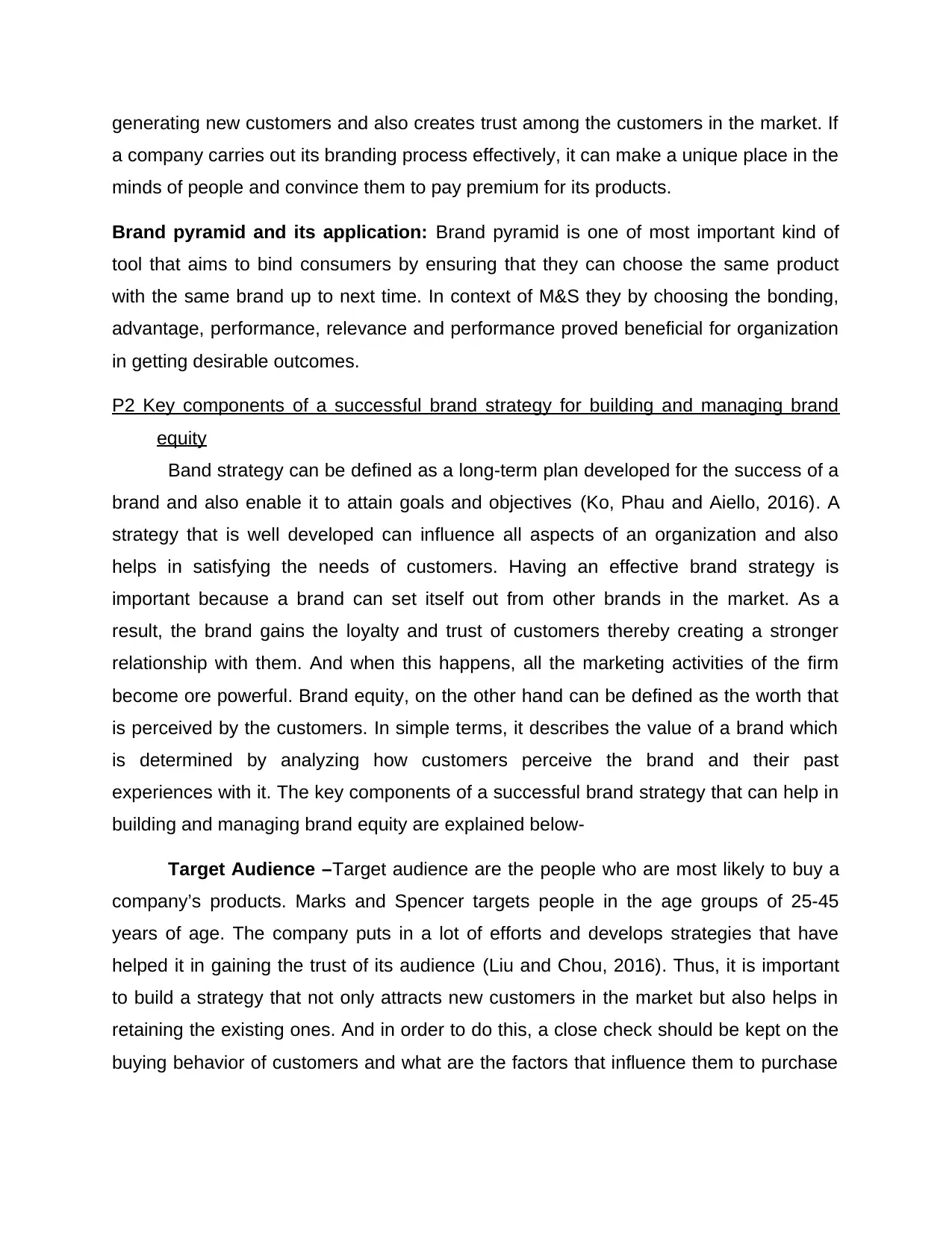
generating new customers and also creates trust among the customers in the market. If
a company carries out its branding process effectively, it can make a unique place in the
minds of people and convince them to pay premium for its products.
Brand pyramid and its application: Brand pyramid is one of most important kind of
tool that aims to bind consumers by ensuring that they can choose the same product
with the same brand up to next time. In context of M&S they by choosing the bonding,
advantage, performance, relevance and performance proved beneficial for organization
in getting desirable outcomes.
P2 Key components of a successful brand strategy for building and managing brand
equity
Band strategy can be defined as a long-term plan developed for the success of a
brand and also enable it to attain goals and objectives (Ko, Phau and Aiello, 2016). A
strategy that is well developed can influence all aspects of an organization and also
helps in satisfying the needs of customers. Having an effective brand strategy is
important because a brand can set itself out from other brands in the market. As a
result, the brand gains the loyalty and trust of customers thereby creating a stronger
relationship with them. And when this happens, all the marketing activities of the firm
become ore powerful. Brand equity, on the other hand can be defined as the worth that
is perceived by the customers. In simple terms, it describes the value of a brand which
is determined by analyzing how customers perceive the brand and their past
experiences with it. The key components of a successful brand strategy that can help in
building and managing brand equity are explained below-
Target Audience –Target audience are the people who are most likely to buy a
company’s products. Marks and Spencer targets people in the age groups of 25-45
years of age. The company puts in a lot of efforts and develops strategies that have
helped it in gaining the trust of its audience (Liu and Chou, 2016). Thus, it is important
to build a strategy that not only attracts new customers in the market but also helps in
retaining the existing ones. And in order to do this, a close check should be kept on the
buying behavior of customers and what are the factors that influence them to purchase
a company carries out its branding process effectively, it can make a unique place in the
minds of people and convince them to pay premium for its products.
Brand pyramid and its application: Brand pyramid is one of most important kind of
tool that aims to bind consumers by ensuring that they can choose the same product
with the same brand up to next time. In context of M&S they by choosing the bonding,
advantage, performance, relevance and performance proved beneficial for organization
in getting desirable outcomes.
P2 Key components of a successful brand strategy for building and managing brand
equity
Band strategy can be defined as a long-term plan developed for the success of a
brand and also enable it to attain goals and objectives (Ko, Phau and Aiello, 2016). A
strategy that is well developed can influence all aspects of an organization and also
helps in satisfying the needs of customers. Having an effective brand strategy is
important because a brand can set itself out from other brands in the market. As a
result, the brand gains the loyalty and trust of customers thereby creating a stronger
relationship with them. And when this happens, all the marketing activities of the firm
become ore powerful. Brand equity, on the other hand can be defined as the worth that
is perceived by the customers. In simple terms, it describes the value of a brand which
is determined by analyzing how customers perceive the brand and their past
experiences with it. The key components of a successful brand strategy that can help in
building and managing brand equity are explained below-
Target Audience –Target audience are the people who are most likely to buy a
company’s products. Marks and Spencer targets people in the age groups of 25-45
years of age. The company puts in a lot of efforts and develops strategies that have
helped it in gaining the trust of its audience (Liu and Chou, 2016). Thus, it is important
to build a strategy that not only attracts new customers in the market but also helps in
retaining the existing ones. And in order to do this, a close check should be kept on the
buying behavior of customers and what are the factors that influence them to purchase
⊘ This is a preview!⊘
Do you want full access?
Subscribe today to unlock all pages.

Trusted by 1+ million students worldwide
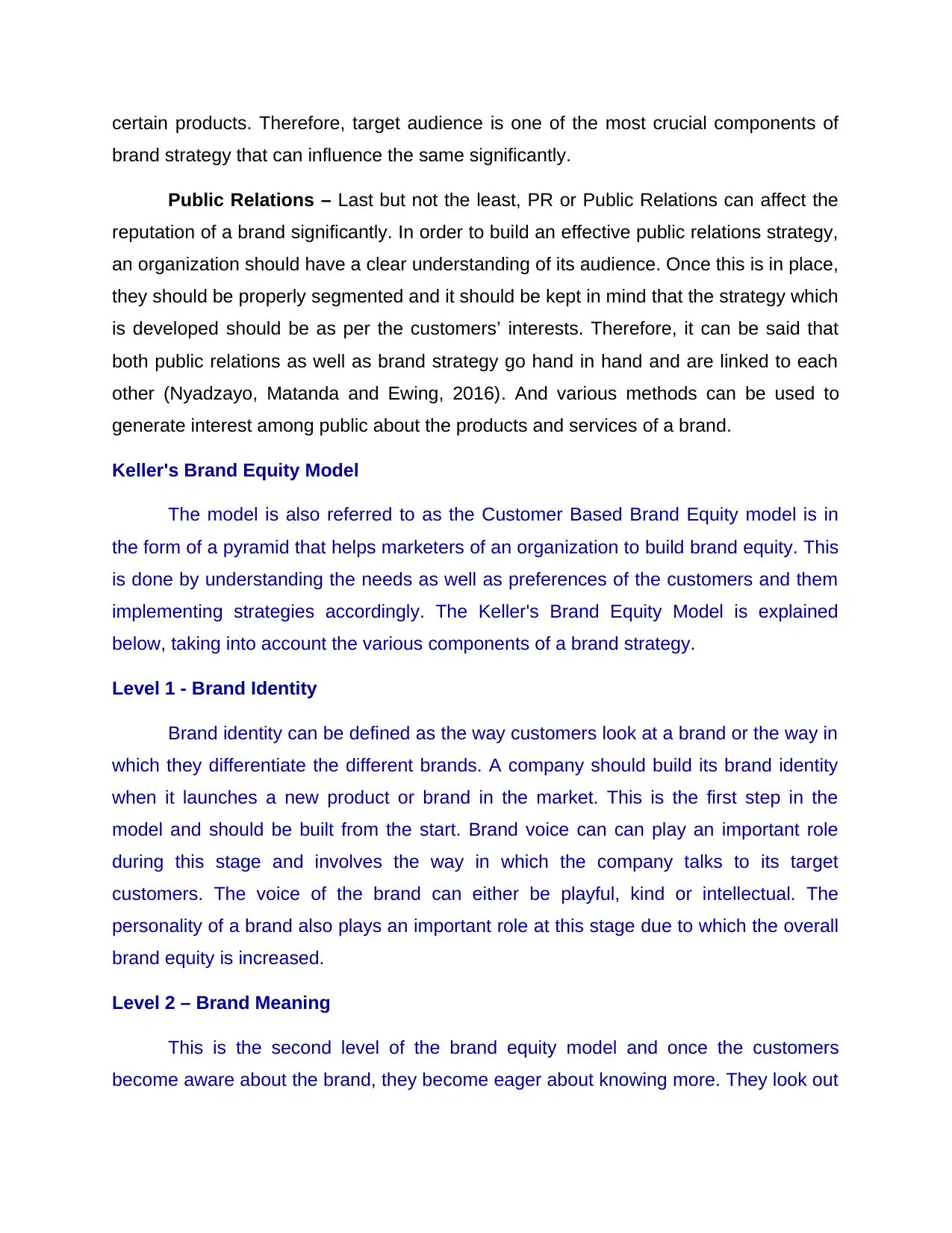
certain products. Therefore, target audience is one of the most crucial components of
brand strategy that can influence the same significantly.
Public Relations – Last but not the least, PR or Public Relations can affect the
reputation of a brand significantly. In order to build an effective public relations strategy,
an organization should have a clear understanding of its audience. Once this is in place,
they should be properly segmented and it should be kept in mind that the strategy which
is developed should be as per the customers’ interests. Therefore, it can be said that
both public relations as well as brand strategy go hand in hand and are linked to each
other (Nyadzayo, Matanda and Ewing, 2016). And various methods can be used to
generate interest among public about the products and services of a brand.
Keller's Brand Equity Model
The model is also referred to as the Customer Based Brand Equity model is in
the form of a pyramid that helps marketers of an organization to build brand equity. This
is done by understanding the needs as well as preferences of the customers and them
implementing strategies accordingly. The Keller's Brand Equity Model is explained
below, taking into account the various components of a brand strategy.
Level 1 - Brand Identity
Brand identity can be defined as the way customers look at a brand or the way in
which they differentiate the different brands. A company should build its brand identity
when it launches a new product or brand in the market. This is the first step in the
model and should be built from the start. Brand voice can can play an important role
during this stage and involves the way in which the company talks to its target
customers. The voice of the brand can either be playful, kind or intellectual. The
personality of a brand also plays an important role at this stage due to which the overall
brand equity is increased.
Level 2 – Brand Meaning
This is the second level of the brand equity model and once the customers
become aware about the brand, they become eager about knowing more. They look out
brand strategy that can influence the same significantly.
Public Relations – Last but not the least, PR or Public Relations can affect the
reputation of a brand significantly. In order to build an effective public relations strategy,
an organization should have a clear understanding of its audience. Once this is in place,
they should be properly segmented and it should be kept in mind that the strategy which
is developed should be as per the customers’ interests. Therefore, it can be said that
both public relations as well as brand strategy go hand in hand and are linked to each
other (Nyadzayo, Matanda and Ewing, 2016). And various methods can be used to
generate interest among public about the products and services of a brand.
Keller's Brand Equity Model
The model is also referred to as the Customer Based Brand Equity model is in
the form of a pyramid that helps marketers of an organization to build brand equity. This
is done by understanding the needs as well as preferences of the customers and them
implementing strategies accordingly. The Keller's Brand Equity Model is explained
below, taking into account the various components of a brand strategy.
Level 1 - Brand Identity
Brand identity can be defined as the way customers look at a brand or the way in
which they differentiate the different brands. A company should build its brand identity
when it launches a new product or brand in the market. This is the first step in the
model and should be built from the start. Brand voice can can play an important role
during this stage and involves the way in which the company talks to its target
customers. The voice of the brand can either be playful, kind or intellectual. The
personality of a brand also plays an important role at this stage due to which the overall
brand equity is increased.
Level 2 – Brand Meaning
This is the second level of the brand equity model and once the customers
become aware about the brand, they become eager about knowing more. They look out
Paraphrase This Document
Need a fresh take? Get an instant paraphrase of this document with our AI Paraphraser

for information about if the brand is good for use over a long duration of time or whether
the service provided by it is good or not. A brand promise refers to either an experience
or a value that a company promises to offer its customers every time they buy its
products. The brand promise of Marks and Spencer is to make the best quality products
accessible to customers through a wide range.
Level 3 - Brand Response
When the customer buys a product of the brand, they build certain expectations
from it. If the product matches their expectations, they will have positive feedback about
the brand. This will lead to creating positive word of mouth and help the company in
attracting potential customers (Liu and et. al., 2016). Brand associations are essential
components that can assist a buyer to recall a particular brand. They also help in
creating positive feelings towards the products of the brand.
Level 4 – Brand Resonance
This is the last stage of the brand equity model and is defined the way in which
the customers relate to the brand. In simple words, brand resonance is defined the way
in which the customers perceive a particular brand of the company. This is where brand
positioning comes into picture and is defined the place a brand wants to own in the
minds of its target audience.
M1 Evaluate how brands are managed successfully over time using application of
appropriate models and concepts
A brand acts as the face of an organization and should be managed in the most
efficient way possible. One of the many ways to manage a brand overtime is to
strengthen its overall brand equity which can be done by developing various programs
to market the products. This helps in expressing the brand knowledge in a consistent
manner so that the customers do not get confused. The brand is defined clearly and
consistent efforts are made to differentiate it in the market. Marks and Spencer rewards
and empowers those customers who have been loyal to the brand from the very start.
Lastly, it is important that the marketing tactics are in line with the overall strategy and
the effectiveness is measured regularly.
the service provided by it is good or not. A brand promise refers to either an experience
or a value that a company promises to offer its customers every time they buy its
products. The brand promise of Marks and Spencer is to make the best quality products
accessible to customers through a wide range.
Level 3 - Brand Response
When the customer buys a product of the brand, they build certain expectations
from it. If the product matches their expectations, they will have positive feedback about
the brand. This will lead to creating positive word of mouth and help the company in
attracting potential customers (Liu and et. al., 2016). Brand associations are essential
components that can assist a buyer to recall a particular brand. They also help in
creating positive feelings towards the products of the brand.
Level 4 – Brand Resonance
This is the last stage of the brand equity model and is defined the way in which
the customers relate to the brand. In simple words, brand resonance is defined the way
in which the customers perceive a particular brand of the company. This is where brand
positioning comes into picture and is defined the place a brand wants to own in the
minds of its target audience.
M1 Evaluate how brands are managed successfully over time using application of
appropriate models and concepts
A brand acts as the face of an organization and should be managed in the most
efficient way possible. One of the many ways to manage a brand overtime is to
strengthen its overall brand equity which can be done by developing various programs
to market the products. This helps in expressing the brand knowledge in a consistent
manner so that the customers do not get confused. The brand is defined clearly and
consistent efforts are made to differentiate it in the market. Marks and Spencer rewards
and empowers those customers who have been loyal to the brand from the very start.
Lastly, it is important that the marketing tactics are in line with the overall strategy and
the effectiveness is measured regularly.
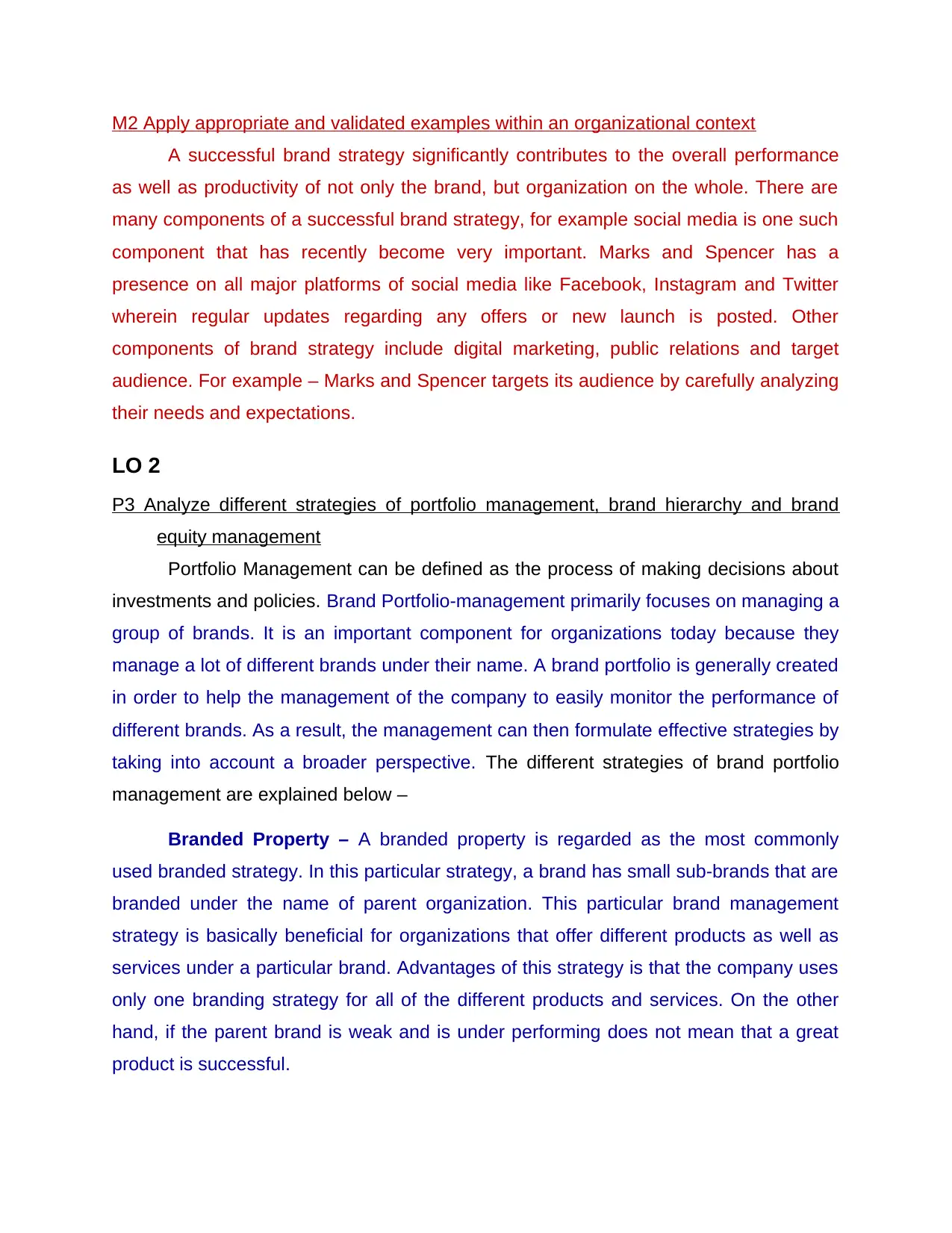
M2 Apply appropriate and validated examples within an organizational context
A successful brand strategy significantly contributes to the overall performance
as well as productivity of not only the brand, but organization on the whole. There are
many components of a successful brand strategy, for example social media is one such
component that has recently become very important. Marks and Spencer has a
presence on all major platforms of social media like Facebook, Instagram and Twitter
wherein regular updates regarding any offers or new launch is posted. Other
components of brand strategy include digital marketing, public relations and target
audience. For example – Marks and Spencer targets its audience by carefully analyzing
their needs and expectations.
LO 2
P3 Analyze different strategies of portfolio management, brand hierarchy and brand
equity management
Portfolio Management can be defined as the process of making decisions about
investments and policies. Brand Portfolio-management primarily focuses on managing a
group of brands. It is an important component for organizations today because they
manage a lot of different brands under their name. A brand portfolio is generally created
in order to help the management of the company to easily monitor the performance of
different brands. As a result, the management can then formulate effective strategies by
taking into account a broader perspective. The different strategies of brand portfolio
management are explained below –
Branded Property – A branded property is regarded as the most commonly
used branded strategy. In this particular strategy, a brand has small sub-brands that are
branded under the name of parent organization. This particular brand management
strategy is basically beneficial for organizations that offer different products as well as
services under a particular brand. Advantages of this strategy is that the company uses
only one branding strategy for all of the different products and services. On the other
hand, if the parent brand is weak and is under performing does not mean that a great
product is successful.
A successful brand strategy significantly contributes to the overall performance
as well as productivity of not only the brand, but organization on the whole. There are
many components of a successful brand strategy, for example social media is one such
component that has recently become very important. Marks and Spencer has a
presence on all major platforms of social media like Facebook, Instagram and Twitter
wherein regular updates regarding any offers or new launch is posted. Other
components of brand strategy include digital marketing, public relations and target
audience. For example – Marks and Spencer targets its audience by carefully analyzing
their needs and expectations.
LO 2
P3 Analyze different strategies of portfolio management, brand hierarchy and brand
equity management
Portfolio Management can be defined as the process of making decisions about
investments and policies. Brand Portfolio-management primarily focuses on managing a
group of brands. It is an important component for organizations today because they
manage a lot of different brands under their name. A brand portfolio is generally created
in order to help the management of the company to easily monitor the performance of
different brands. As a result, the management can then formulate effective strategies by
taking into account a broader perspective. The different strategies of brand portfolio
management are explained below –
Branded Property – A branded property is regarded as the most commonly
used branded strategy. In this particular strategy, a brand has small sub-brands that are
branded under the name of parent organization. This particular brand management
strategy is basically beneficial for organizations that offer different products as well as
services under a particular brand. Advantages of this strategy is that the company uses
only one branding strategy for all of the different products and services. On the other
hand, if the parent brand is weak and is under performing does not mean that a great
product is successful.
⊘ This is a preview!⊘
Do you want full access?
Subscribe today to unlock all pages.

Trusted by 1+ million students worldwide
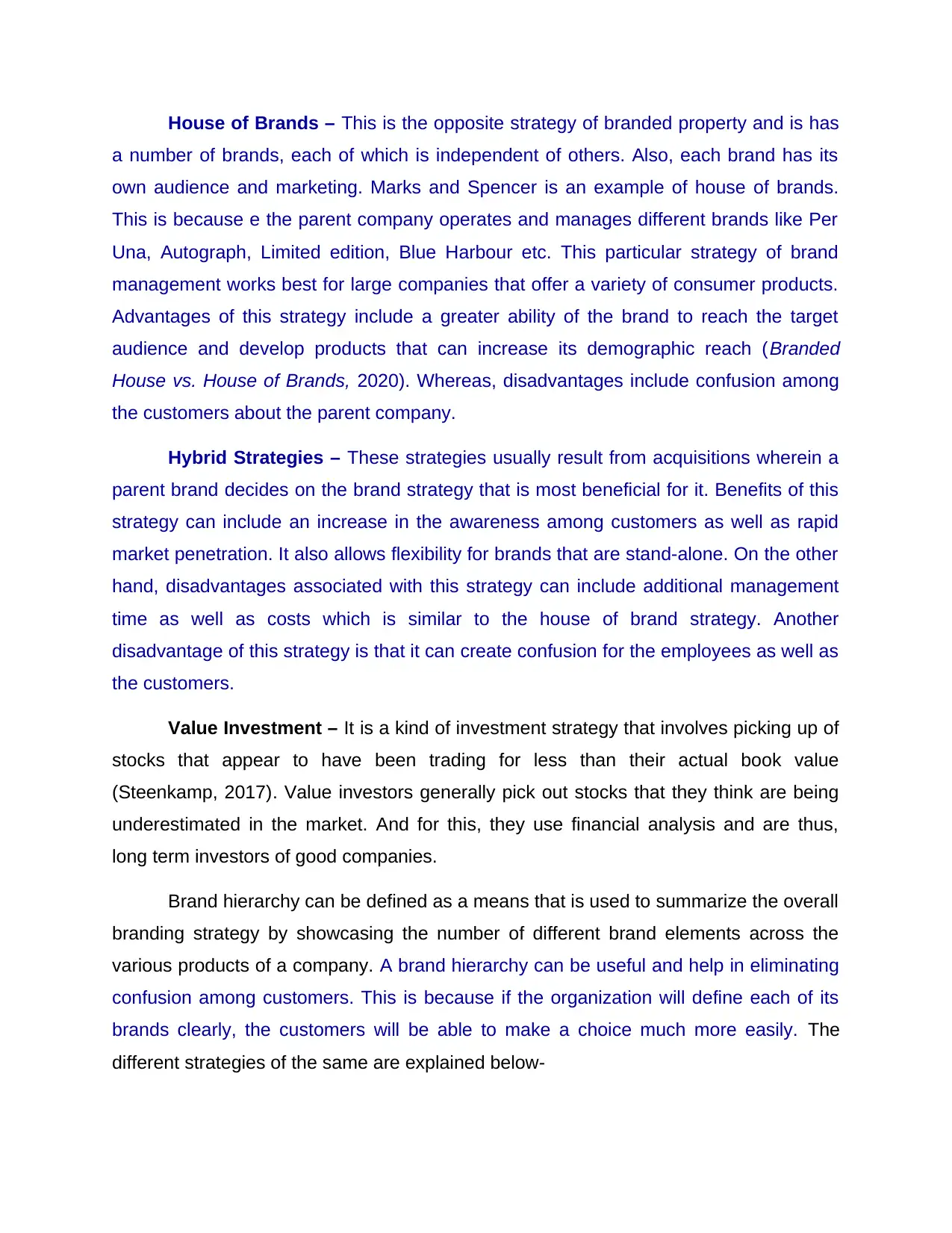
House of Brands – This is the opposite strategy of branded property and is has
a number of brands, each of which is independent of others. Also, each brand has its
own audience and marketing. Marks and Spencer is an example of house of brands.
This is because e the parent company operates and manages different brands like Per
Una, Autograph, Limited edition, Blue Harbour etc. This particular strategy of brand
management works best for large companies that offer a variety of consumer products.
Advantages of this strategy include a greater ability of the brand to reach the target
audience and develop products that can increase its demographic reach (Branded
House vs. House of Brands, 2020). Whereas, disadvantages include confusion among
the customers about the parent company.
Hybrid Strategies – These strategies usually result from acquisitions wherein a
parent brand decides on the brand strategy that is most beneficial for it. Benefits of this
strategy can include an increase in the awareness among customers as well as rapid
market penetration. It also allows flexibility for brands that are stand-alone. On the other
hand, disadvantages associated with this strategy can include additional management
time as well as costs which is similar to the house of brand strategy. Another
disadvantage of this strategy is that it can create confusion for the employees as well as
the customers.
Value Investment – It is a kind of investment strategy that involves picking up of
stocks that appear to have been trading for less than their actual book value
(Steenkamp, 2017). Value investors generally pick out stocks that they think are being
underestimated in the market. And for this, they use financial analysis and are thus,
long term investors of good companies.
Brand hierarchy can be defined as a means that is used to summarize the overall
branding strategy by showcasing the number of different brand elements across the
various products of a company. A brand hierarchy can be useful and help in eliminating
confusion among customers. This is because if the organization will define each of its
brands clearly, the customers will be able to make a choice much more easily. The
different strategies of the same are explained below-
a number of brands, each of which is independent of others. Also, each brand has its
own audience and marketing. Marks and Spencer is an example of house of brands.
This is because e the parent company operates and manages different brands like Per
Una, Autograph, Limited edition, Blue Harbour etc. This particular strategy of brand
management works best for large companies that offer a variety of consumer products.
Advantages of this strategy include a greater ability of the brand to reach the target
audience and develop products that can increase its demographic reach (Branded
House vs. House of Brands, 2020). Whereas, disadvantages include confusion among
the customers about the parent company.
Hybrid Strategies – These strategies usually result from acquisitions wherein a
parent brand decides on the brand strategy that is most beneficial for it. Benefits of this
strategy can include an increase in the awareness among customers as well as rapid
market penetration. It also allows flexibility for brands that are stand-alone. On the other
hand, disadvantages associated with this strategy can include additional management
time as well as costs which is similar to the house of brand strategy. Another
disadvantage of this strategy is that it can create confusion for the employees as well as
the customers.
Value Investment – It is a kind of investment strategy that involves picking up of
stocks that appear to have been trading for less than their actual book value
(Steenkamp, 2017). Value investors generally pick out stocks that they think are being
underestimated in the market. And for this, they use financial analysis and are thus,
long term investors of good companies.
Brand hierarchy can be defined as a means that is used to summarize the overall
branding strategy by showcasing the number of different brand elements across the
various products of a company. A brand hierarchy can be useful and help in eliminating
confusion among customers. This is because if the organization will define each of its
brands clearly, the customers will be able to make a choice much more easily. The
different strategies of the same are explained below-
Paraphrase This Document
Need a fresh take? Get an instant paraphrase of this document with our AI Paraphraser
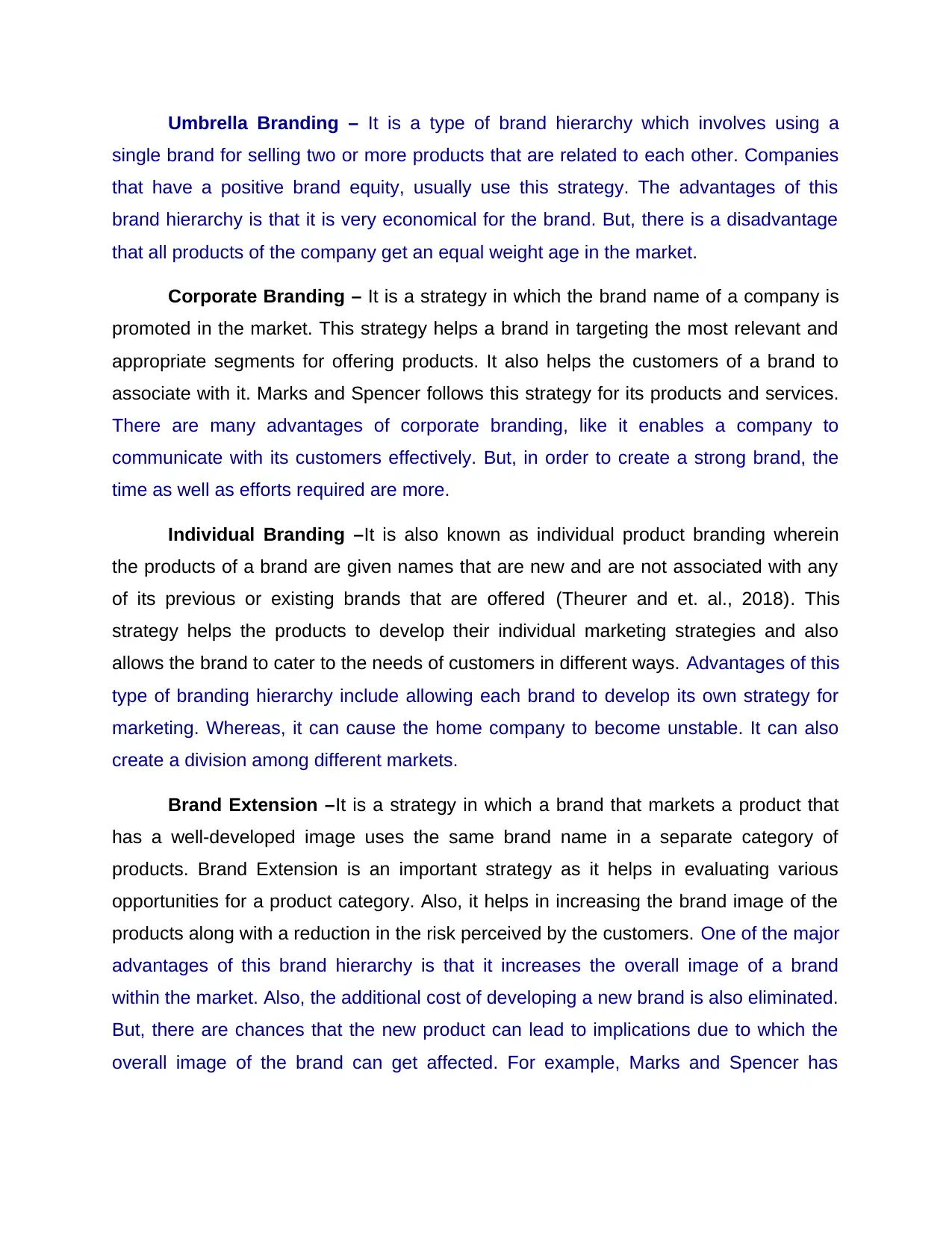
Umbrella Branding – It is a type of brand hierarchy which involves using a
single brand for selling two or more products that are related to each other. Companies
that have a positive brand equity, usually use this strategy. The advantages of this
brand hierarchy is that it is very economical for the brand. But, there is a disadvantage
that all products of the company get an equal weight age in the market.
Corporate Branding – It is a strategy in which the brand name of a company is
promoted in the market. This strategy helps a brand in targeting the most relevant and
appropriate segments for offering products. It also helps the customers of a brand to
associate with it. Marks and Spencer follows this strategy for its products and services.
There are many advantages of corporate branding, like it enables a company to
communicate with its customers effectively. But, in order to create a strong brand, the
time as well as efforts required are more.
Individual Branding –It is also known as individual product branding wherein
the products of a brand are given names that are new and are not associated with any
of its previous or existing brands that are offered (Theurer and et. al., 2018). This
strategy helps the products to develop their individual marketing strategies and also
allows the brand to cater to the needs of customers in different ways. Advantages of this
type of branding hierarchy include allowing each brand to develop its own strategy for
marketing. Whereas, it can cause the home company to become unstable. It can also
create a division among different markets.
Brand Extension –It is a strategy in which a brand that markets a product that
has a well-developed image uses the same brand name in a separate category of
products. Brand Extension is an important strategy as it helps in evaluating various
opportunities for a product category. Also, it helps in increasing the brand image of the
products along with a reduction in the risk perceived by the customers. One of the major
advantages of this brand hierarchy is that it increases the overall image of a brand
within the market. Also, the additional cost of developing a new brand is also eliminated.
But, there are chances that the new product can lead to implications due to which the
overall image of the brand can get affected. For example, Marks and Spencer has
single brand for selling two or more products that are related to each other. Companies
that have a positive brand equity, usually use this strategy. The advantages of this
brand hierarchy is that it is very economical for the brand. But, there is a disadvantage
that all products of the company get an equal weight age in the market.
Corporate Branding – It is a strategy in which the brand name of a company is
promoted in the market. This strategy helps a brand in targeting the most relevant and
appropriate segments for offering products. It also helps the customers of a brand to
associate with it. Marks and Spencer follows this strategy for its products and services.
There are many advantages of corporate branding, like it enables a company to
communicate with its customers effectively. But, in order to create a strong brand, the
time as well as efforts required are more.
Individual Branding –It is also known as individual product branding wherein
the products of a brand are given names that are new and are not associated with any
of its previous or existing brands that are offered (Theurer and et. al., 2018). This
strategy helps the products to develop their individual marketing strategies and also
allows the brand to cater to the needs of customers in different ways. Advantages of this
type of branding hierarchy include allowing each brand to develop its own strategy for
marketing. Whereas, it can cause the home company to become unstable. It can also
create a division among different markets.
Brand Extension –It is a strategy in which a brand that markets a product that
has a well-developed image uses the same brand name in a separate category of
products. Brand Extension is an important strategy as it helps in evaluating various
opportunities for a product category. Also, it helps in increasing the brand image of the
products along with a reduction in the risk perceived by the customers. One of the major
advantages of this brand hierarchy is that it increases the overall image of a brand
within the market. Also, the additional cost of developing a new brand is also eliminated.
But, there are chances that the new product can lead to implications due to which the
overall image of the brand can get affected. For example, Marks and Spencer has
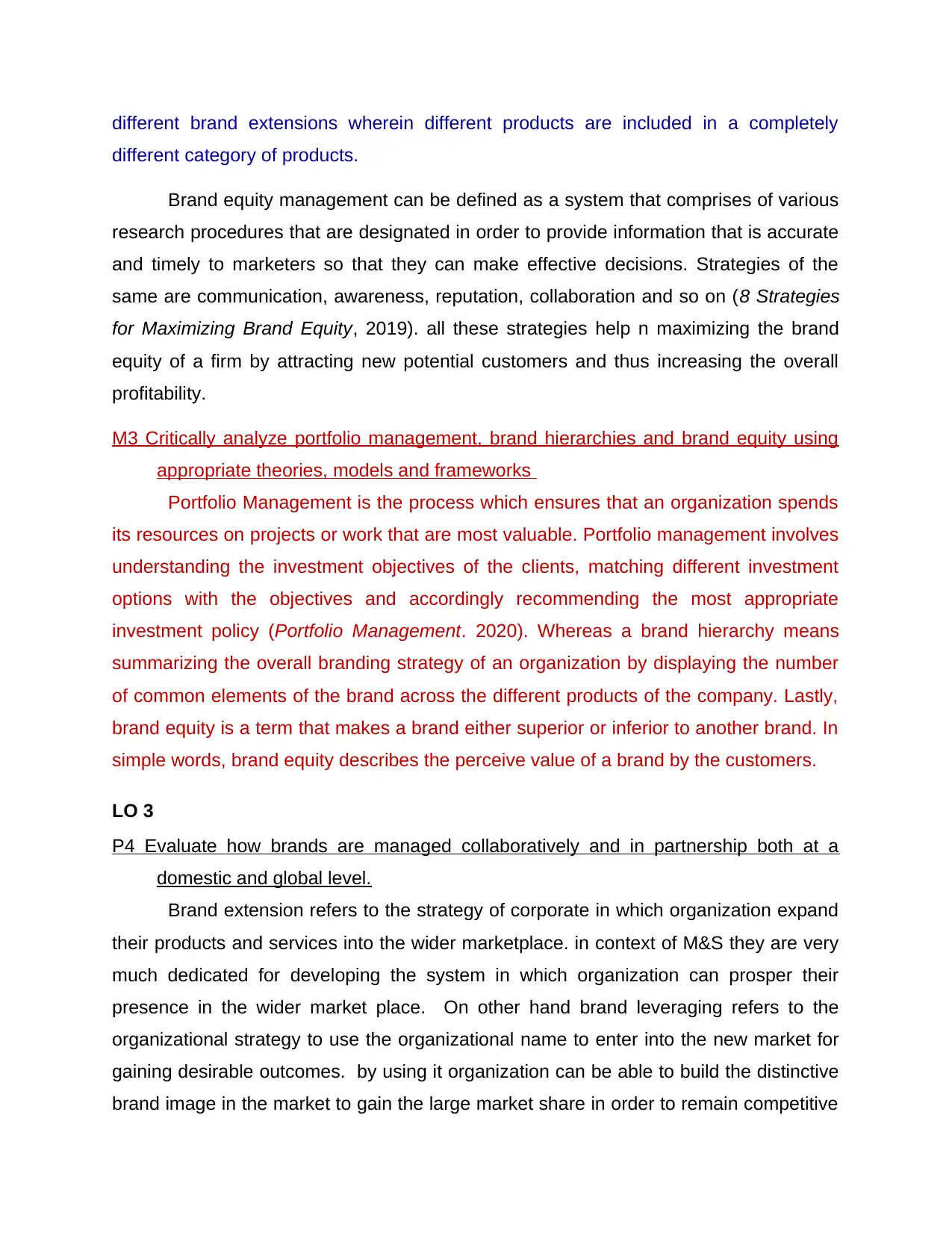
different brand extensions wherein different products are included in a completely
different category of products.
Brand equity management can be defined as a system that comprises of various
research procedures that are designated in order to provide information that is accurate
and timely to marketers so that they can make effective decisions. Strategies of the
same are communication, awareness, reputation, collaboration and so on (8 Strategies
for Maximizing Brand Equity, 2019). all these strategies help n maximizing the brand
equity of a firm by attracting new potential customers and thus increasing the overall
profitability.
M3 Critically analyze portfolio management, brand hierarchies and brand equity using
appropriate theories, models and frameworks
Portfolio Management is the process which ensures that an organization spends
its resources on projects or work that are most valuable. Portfolio management involves
understanding the investment objectives of the clients, matching different investment
options with the objectives and accordingly recommending the most appropriate
investment policy (Portfolio Management. 2020). Whereas a brand hierarchy means
summarizing the overall branding strategy of an organization by displaying the number
of common elements of the brand across the different products of the company. Lastly,
brand equity is a term that makes a brand either superior or inferior to another brand. In
simple words, brand equity describes the perceive value of a brand by the customers.
LO 3
P4 Evaluate how brands are managed collaboratively and in partnership both at a
domestic and global level.
Brand extension refers to the strategy of corporate in which organization expand
their products and services into the wider marketplace. in context of M&S they are very
much dedicated for developing the system in which organization can prosper their
presence in the wider market place. On other hand brand leveraging refers to the
organizational strategy to use the organizational name to enter into the new market for
gaining desirable outcomes. by using it organization can be able to build the distinctive
brand image in the market to gain the large market share in order to remain competitive
different category of products.
Brand equity management can be defined as a system that comprises of various
research procedures that are designated in order to provide information that is accurate
and timely to marketers so that they can make effective decisions. Strategies of the
same are communication, awareness, reputation, collaboration and so on (8 Strategies
for Maximizing Brand Equity, 2019). all these strategies help n maximizing the brand
equity of a firm by attracting new potential customers and thus increasing the overall
profitability.
M3 Critically analyze portfolio management, brand hierarchies and brand equity using
appropriate theories, models and frameworks
Portfolio Management is the process which ensures that an organization spends
its resources on projects or work that are most valuable. Portfolio management involves
understanding the investment objectives of the clients, matching different investment
options with the objectives and accordingly recommending the most appropriate
investment policy (Portfolio Management. 2020). Whereas a brand hierarchy means
summarizing the overall branding strategy of an organization by displaying the number
of common elements of the brand across the different products of the company. Lastly,
brand equity is a term that makes a brand either superior or inferior to another brand. In
simple words, brand equity describes the perceive value of a brand by the customers.
LO 3
P4 Evaluate how brands are managed collaboratively and in partnership both at a
domestic and global level.
Brand extension refers to the strategy of corporate in which organization expand
their products and services into the wider marketplace. in context of M&S they are very
much dedicated for developing the system in which organization can prosper their
presence in the wider market place. On other hand brand leveraging refers to the
organizational strategy to use the organizational name to enter into the new market for
gaining desirable outcomes. by using it organization can be able to build the distinctive
brand image in the market to gain the large market share in order to remain competitive
⊘ This is a preview!⊘
Do you want full access?
Subscribe today to unlock all pages.

Trusted by 1+ million students worldwide
1 out of 20
Related Documents
Your All-in-One AI-Powered Toolkit for Academic Success.
+13062052269
info@desklib.com
Available 24*7 on WhatsApp / Email
![[object Object]](/_next/static/media/star-bottom.7253800d.svg)
Unlock your academic potential
Copyright © 2020–2025 A2Z Services. All Rights Reserved. Developed and managed by ZUCOL.


